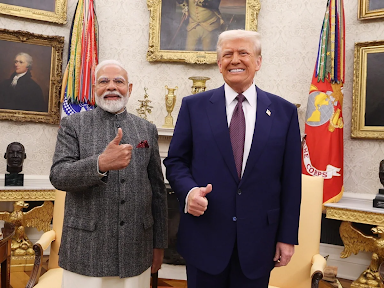India-US mini trade deal likely today to avoid tariffs
Trump postponed the reciperook tariff for 90 days. Its deadline ends on 9 July.
The mini trade deal between India and the US is expected to be announced by late tonight. This deal can open new routes for Indian exporters and American markets. On April 2, US President Donald Trump imposed a reciperook tariff on countries around the world, later postponed for 90 days. Its deadline ends on 9 July 2025. In such a situation, this deal is very important.
Come, let us understand this whole matter through question and answer…
Question 1: What is Indo-US mini trade deal?
answer: Mini trade deal is a small and limited trading agreement, in which both countries have agreed to reduce tariffs (custom duty) on certain goods and increase business. This is not a major free trade agreement (FTA), but an early step, which includes some sectors and the rest of the complex issues have been left for later.
This deal between India and the US is especially focusing on automobiles, textile, medicines, and some agricultural products. Its purpose is to make trade between the two countries easier and reduce the obstacles caused by tariffs.

Question 2: Why did the negotiation of this deal start?
answer: The major reason for the introduction of this deal is the decision taken by US President Donald Trump on 2 April 2025, in which he announced a 26% recipe tariff (counter -fee) on several countries including India. It was later postponed for 90 days.
Its deadline ends on 9 July 2025. If there is no deal till this deadline, then there may be a huge tariff of 26% on goods going from India to America. India wants to remove this tariff. On the other hand, the US wants India to give its agriculture and dairy products more space in its market.
Question 3: What is involved in this deal?
answer: According to sources, these are important points in the mini trade deal:
- India’s offer: India is willing to reduce tariffs on the American Pekan nuts (a kind of almonds), blueberries, and some other agricultural products. Also, a concession can be given in tariffs on automobiles and some industrial goods.
- America demands: The US wants India to reduce tariffs on its dairy products, genetically modified (GM) crops, and agricultural products like apples, almonds, pistachios.
- What was excluded: India has made it clear that sensitive sectors like rice, wheat, maize, dairy, and GM crops will not be part of this deal. India says that these sectors are very important for small and marginal farmers, and it will be harmful for them to give concession on them.
- Tariff conditions: The average tariff in this deal is expected to be around 10%. India wants the US to remove 26% of recipe rockel tariffs and 10% baseline tariffs completely, but the US can maintain 10% tariff right now.
Question 4: How far has the conversation of this deal reached?
answer: As of 7 July 2025, India and America teams are talking in Washington. Sources say that most parts of the deal have been agreed, and it may be announced on late night or 8 July. Commerce Minister Piyush Goyal has said that India will keep national interests at the top.
Question 5: What will be the benefit of India and America from this deal?
answer: If it gets a mini trade deal, then:
Benefits for India,
- Textile, medicines, jewelery will get more access to the US market.
- Indian exports will be cheaper by the removal of 26% reciperook tariff, which will increase trade.
- By 2030, India-US bilateral trade can reach $ 500 billion.
Benefits for America,
- Products like Pekan Nuts, Blueberry, and Automobiles will get a chance to sell on low tariffs in India.
- Business relations with India will be strengthened, which is important to counter China’s influence in the Asia-Pacific sector.
For both countries: This deal can lay the foundation of big free trade agreement (FTA) in future.

Question 6: What were the obstacles in the deal?
answer: Some big screws were stuck in the conversation:
- Disagreement over agriculture and dairy: America was demanding the sale of GM crops and dairy products in India, but India rejected it outright.
- Differences over tariffs: India wants the US to completely remove 26% reciperook tariffs and 10% baseline tariffs, but the US wants to maintain 10% tariffs.
- Trump’s pressure: Trump had said that the countries who do not deal till 9 July, will have to face tariffs. India made it clear that it would not bow under pressure.
Question 8: What will be the geopolitical effect of this deal?
answer: This deal is not limited to trade, it also has strategic importance:
- Strategy against China: This agreement between India and America is part of countering China’s growing influence in Asia-Pacific. The relationship between the two countries under Quad (India, America, Japan, Australia) will be stronger.
- Russia and oil imports: India is knocking America to buy cheap oil from Russia. Trump has proposed 500% tariff on trading countries with Russia, but this deal may provide some relief to India.




